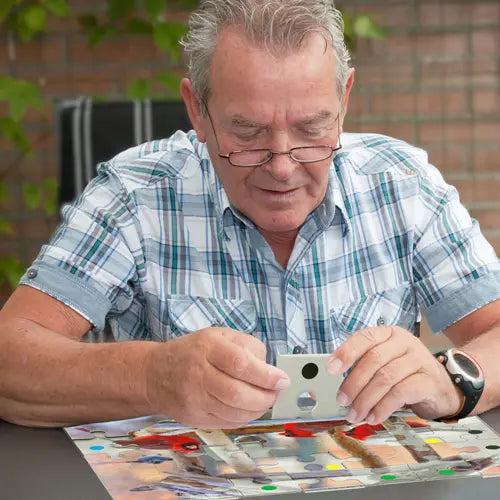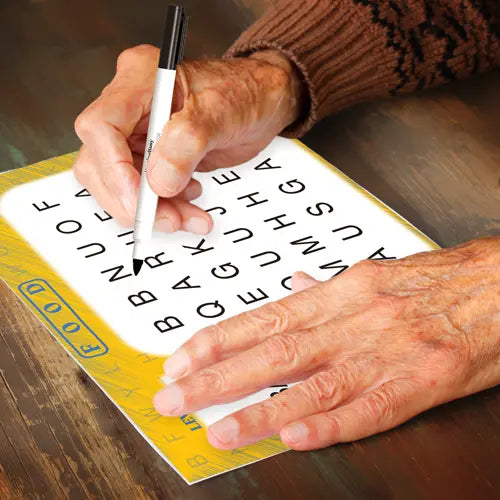
When we offer an activity to someone with dementia, we should do everything we can to ensure their success. We generally focus on the person's abilities when deciding if an activity is appropriate, but other factors are also important. Vision is one such factor. Even without any underlying problems, our vision deteriorates as we age. Disorders such as age-related macular degeneration or cataracts can make matters far worse. Before choosing an activity, it is important to ensure that the person's vision will not hinder them in being successful.
We can help by ensuring that the environment is set up to offer the most chance of success, as described in our article "Presenting an Activity to Someone with Dementia, Start to Finish". When someone has vision problems it is also important to
- Ensure that they are they wearing their glasses
- Ensure that their glasses are clean
- Check that the lighting is appropriate
- Make sure that there is no glare (on laminated sheets, for example)
It is also important to know what size type the person can read. To determine this, download and complete the Sight and Reading Ability Assessment (courtesy of DementiAbility Enterprises). With this information in hand, you may discover that the person was unsuccessful with an activity in the past not because it was too challenging, but rather because of a vision issue. There is no point in offering an activity that depends on reading a font that is too small for the person.
Our easy large print Word Search activities, for example, come in three levels of difficulty. Not only is each successive level more challenging, the type gets smaller and closer together with each level. Someone can do Level 1, which has large, 40 point type, readily but struggles with Level 2 (which has smaller type, spaced closer together) may have trouble not because the puzzle is too challenging but rather because they can't see the letters properly.
Instead of going back to Level 1, which the person may quickly tire of because it is too easy, we need to provide additional support to compensate for the person’s vision. After all, our goal is to provide the activity at the level that offers the “just right” challenge for the person – not too easy so that it is boring and not so difficult that it is frustrating. In this case, it is not necessarily that the Level 2 puzzle is too challenging, but rather that it is frustrating because they can’t see it. In this case, our Low Vision Level 2 dementia word search with larger type and wider spacing may provide the necessary challenge.
Also be aware of color blindness, or difficulty in distinguishing between similar colors. If the activity depends on the person recognizing different colors but they can't tell them apart, they are not going to be successful and will quickly become frustrated. Once you are aware of the problems, you can watch for them and be creative in finding ways to overcome them. A handy tool is a tactile marker that leaves a raised line that can be felt rather than having to depend on vision to see the line. It can be used to outline shapes on templates and put distinguishing marks on pieces.
HERE ARE SOME IDEAS IF THE TYPE IS TOO SMALL:
- Paste a label with larger print over top
- Print a separate sheet with larger type
- Use a photocopier (or scanner) to enlarge the print
- Read the information to the person rather than have them read it
- Go over the print with a marker to make it stand out more
IF COLOR IS AN ISSUE:
- Use markers or pens to brighten the colors or make them more distinguishable
- Put a symbol for each color on the pieces so that they can be differentiated without depending on the color
- Organize the pieces into groupings of colors that the person can distinguish
- Enlarge the colored area with markers or pens to make it easier to identify
- Use a tactile marker (or drops of glue or rubber cement) on each piece so that the person can touch the pieces to distinguish between them without depending on the color
Another approach is to select activities that don’t rely on sight. Consider the other senses – smell, taste, hearing and touch. Here are some ideas of activities that do not have to rely on sight, or can be modified as needed.
- Match the Photos If the photo cards are too hard to see, try enlarging them or make up your own cards with large print instead of the image.
- Make up a similar matching activity with the names of musical instruments or animals or anything else of interest and match them to sounds played on your computer or tablet.
- Make up 3 x 3 bingo cards that are easy to read with the names or pictures of musical instruments or animals (such as our Animal Picture Bingo activity) instead of numbers in a large font. Play the sound, have the person identify it and then see if they have it on their card.
- Expressions Game which uses a large, easy to read font. If they are unable to read the cards themselves, you can read them out loud and let the person complete the expression.
- Tangram, using the tactile marker (or rubber cement) to outline the shapes on the templates. An added benefit would be that the pieces would be held in place by the raised line.
Be creative, and be persistent. Try different techniques to find what works.




